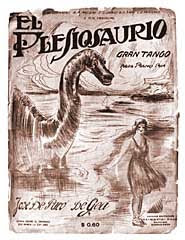El Plesiosauro [sic]. Was a tango composed in 1922 by Rafael D'Agostino (Music) and Amílcar Morbidelli (Lyrics). It was during the media rage that followed the sensational piece of news that a plesiosaur was alive in Patagonia.
"El Plesosaurio" tango poster.
Plesiosaurs (which in Greek means “close to a lizard”), were large aquatic reptiles -but not dinosaurs- that lived at the same time as the dinosaurs.
They were sea creatures that had a broad stocky body, a short tail and turtle-like flippers. Most had small heads and slender necks and measured between 3 and 20 m (10 – 66 ft.) long. As marine reptiles, plesiosaurs had a worldwide distribution and their fossilized remains have been found in northern and central Patagonia.
Though they became extinct together with the dinosaurs 65 Ma., in the early XXth century, one was allegedly seen alive in Patagonia by an American hunter and gold prospector, Martin Sheffield.
On January 19th 1922 Sheffield wrote a very strange letter to Clemente Onelli, the Director of the Buenos Aires Zoo, telling him that he had sighted a very strange creature.
Clemente Onelli (1864-1924). Italian, he migrated to Argentina in 1889 where he befriended Francisco Moreno whom employed him as a naturalist and explorer at his La Plata Science Museum and as such explored the Patagonia. He was fluent in Tehuelche languages and was well acquainted with their beliefs. Later he would be a member of the Chilean Argentine Border Commission and from 1904 until his death he was Director of the Buenos Aires Zoo. See our post with a photograph of Onelli.
Onelli who had visited the region many times as a member of the Argentine-Chilean Border Commission, knew Sheffield. So it is likely that this previous acquaintance prompted Sheffield to write to Onelli. His letter said the following:
Allow me to bring to your attention the following phenomenon that surely will awaken your vivid interest because it deals with the possible entry to your zoo of an animal until now ignored by the world. I will narrate the facts:
For some nights now, I have been noticing some tracks in the grass close to the lake where I have set up my hunting lodge; the track is similar to the foot print of a very heavy foot, the grass remains squashed and does not rise again which leads me to believe that the animal that dragged itself through there must have an enormous weight; I have been able to see, in the middle of the lake, an enormous animal with a head like a swan and enormous size and the movement in the water makes me suppose a crocodile body.[1]
He also suggested that the animal could be hunted and detailed the necessary equipment (harpoons, boat and embalming materials).
Once Onelli made the letter’s contents public, it quickly caused a stir and an expedition was promptly organized to search for and capture the beast that was named “the plesiosaur” by the media.
The news traveled around the world –this was eleven years before Nessie (of Loch Ness fame) was mentioned- and headlines in Europe and the U.S. would report the progress of the expedition.
It was in this context that the tango was written (notice that Onelli is mentioned in it). My "rough" translation of the song is:
I am a poor 'looked for animal'
by those ungrateful and without conscience.
Because I am rare and also curious
(as say the people over there)
Leave mm here, alone, enjoying,
in the loneliness of this lake.
What will you attain by catching me
if it is in vain to take me away alive from this place?
Don't the gentlemen know
that this is not plucking flowers?
They expect to hunt me here
and take me as if I were nothing.
Damned! Don't name me.
I owe you nothing Onelli.
Let me live with the same prerogatives
as you live there.
The original Spanish version is [2]:
Yo soy un pobre animal buscado
por los ingratos y sin conciencia.
Porque soy raro y también lo soy curioso
(según dice la gente allí).
Dejemen solo aquí, gozando
en la soledad de este lago
¿Qué es lo que haréis con sacarme si es en vano
llevarme vivo de este lugar?
¿No saben los señores
que esto no es coger flores?
Pretenden aquí cazarme y llevar
como si nada fuera.
¡Maldito! No me nombres.
Nada te debo Onelli.
Deja que yo viva con igual prerrogativas
como tú vives allí.
I have posted about the incredible Plesiosaur Expedition (it is a three part post).
Bibliography.
[1] Fort, C. (1931). LO!. New York: Claude Kendall. pp. 110. For the original Spanish version of letter, see: El Plesiosaurio Online resource.
[2] Todo Tango.com.
Copyright 2009 by Austin Whittall ©
Patagonian Monsters

















No comments:
Post a Comment